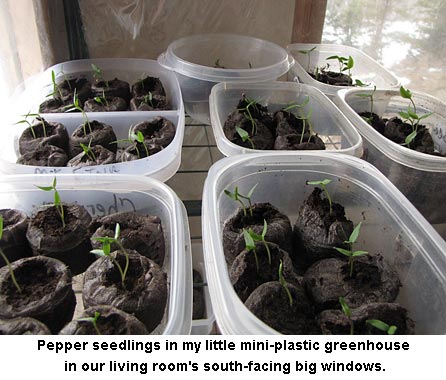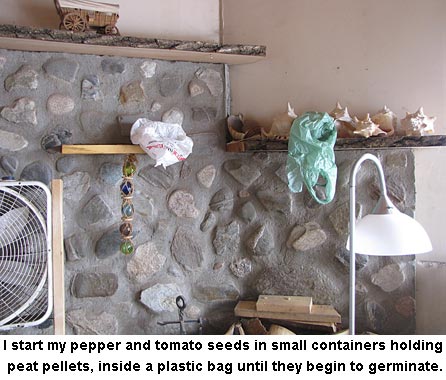Although we had temps of -2 last night, we are excited that our first pepper seedlings are up and looking great. We start them in peat pellets, soaked in hot water to puff them up, and then plant two seeds per pellet so we can choose the strongest plant to let grow. Sometimes we gently tease one plant out and transplant it while very young into its own peat pellet to grow on. Once a small container of one variety has been planted and labeled, I stick them in plastic bags or bread wrappers to hold in moisture and place them on the shelves behind and beside the wood stove where it is very warm. (Peppers germinate best in temps of 80-85 degrees!) Ours come up within five days or less and pop up very strong.
This year we’re trying some different ones, as usual. We’re adding Franks (a green sweet bell pepper from Sand Hills Preservation Center that’s early and hugely productive), a “bootlegged” hot pepper from Venice a reader sent us, which we’ve named “Bootleg,” Medusa, a container-type decorative mild multi-colored wild pepper we love the look of and New Mexico Big Jim, a large, medium heat chile pepper from, yep, New Mexico!
And beans! We have some VERY neat, new beans from all over the world to try — beans from Africa, South America, Poland, Finland, Native American tribes all across the country, some from the Old South, some from the far north. What fun the garden will be this year! I can’t wait. All those new looks and tastes. — Jackie





Jackie what size peat pellets do you use and where do you recommend buying them?
Grew your Bill Bean’s last year and they were the bomb! raves all around from picky summer tomato eaters
Growing again this year of course :)
will send some photos your way
Thanks!
Jackie,
Didn’t I see where you had wild plum seeds for sale on your page. I can’t find them there now. Let me know if you still do. Thank you!
We love the New Mexico Big Jims, seeds purchased in 2015 in Hatch, NM. We also love the Lumbre Xtra hot, & New Mexico 6-4 mild. They grow very well in our hoop house, here in northern Wyoming with the warm humid environment. They grow pretty tall but we haven’t had problems with them falling over either. Hopeing you have good lick also.
We love the New Mexico Big Jims, seeds purchased in 2015 in Hatch, NM. We also love the Lumbre Xtra hot, & New Mexico 6-4 mild. They grow very well in our hoop house, here in northern Wyoming with the warm humid environment. They grow pretty tall but we haven’t had problems with them falling over either.
Zelda,
I’ll sure keep you in mind. Although we have 120 acres, not all is fenced and the deer love our gardens! So far we only have three acres fenced against those critters. Although pole beans tend to be pretty promiscuous, if you can keep them 20 feet apart or thereabouts, they won’t usually cross. Bush beans are much better behaved and will keep to themselves when only a few feet apart.
And as for the stringless beans, true most older snap beans were stringed if they got older but many, such as Cherokee Trail of Tears and Iroquois ARE very old and don’t have strings, IF they are picked quite young, before the seeds are “bumpy” in the pods.
I disagree with the runners on old beans as many ancient beans don’t have runners. Some, called half-runners, DO have runners. I have some Hopi Black beans which are 1,000 years old and don’t have runners, but are a true bush bean. Some half-runners will run up poles four or five feet high where others just kind of tangle together in the bush.
Jackie, re beans said to be very old/ancient native American varities, if they are stringless it’s very unlikely to be true because stringless beans are not known to have existed in America before 1884 and were not commercially available until about 1894. Stringless beans were selectively bred from old time stringed beans, the kind that had to have the string pulled off before they were cut up for cooked beans or cooked whole. I remember people growing stringed beans when I was a child, and taking the strings off before they were canned or cooked. The strings were very tough and could not be chewed enough to be eaten. The other characteristic you can look for in your growouts to verify the age of a bean is runners on bush beans. If there are no runners, the bean is not an old one. Ancient bush beans always have runners but they have been bred out of modern beans since the 1800s. I grew an old old bean last year that had runners at least 2 feet long, some longer.
Jackie I am looking for a very productive, short season, cold and cold soil tolerant climbing or bush Borlotti (aka Borlotto) bean – the real thing, not a wannabe. If anyone sends you anything like that I’d gladly buy and trial them for you if you don’t have enough space. And I can isolate them – all beans cross very easily as far as I know.
Looking forward to all those different beans. That is great to hear!
Elizabeth,
Petunias are tiny, indeed, then they are young. But wait a couple of weeks and all of a sudden they look like little plants….then bigger ones. Hang in there; they’ll be worth the wait.
My peppers are up too! So are the petunias! This is the first time I’ve tried petunias from seed and they look a little puny~ nothing like the robust peppers.
I visit them all everyday in our basement garden, smelling the moist soil, cheering the baby plants towards hardy growth. My family thinks I’m becoming a little, um, weird. But I can’t help it. We’ve had so much snow that the little plantlings are almost soothing to my white weary eyes.
Can’t wait for spring!
Hi Jackie
Your variety of peppers sounds fun AND delicious! Just starting my pepper and petunias as well. I think we are going to have a early spring down here in the cities, but still don’t want to rush, ’cause mother nature has a way of putting us in our place sometimes! Have a great Wednesday!
Lisa
Comments are closed.